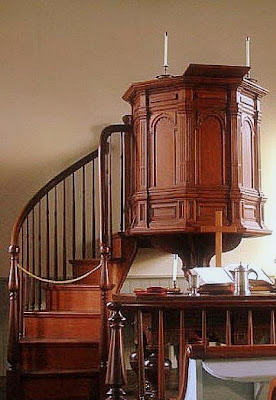
The Wittenberg Door regrets
"The Loss of Symbolism," specifically what seems an aversion to the pulpit, which the pastor once ascended to preach the Word. He argues that the pulpit symbolized something very important in Christian — and particularly Reformed — doctrine.
The pulpit comprises a lectern standing upon a raised platform. Being the most important piece of “furniture” in the church, it is positioned in front of the congregation, with all pews facing it. Its symbolic importance can be summarized as follows:
- It’s central—The pulpit’s central placement is important because it is from there that God addresses His people via the preached word. Therefore, it commands the most prominent place in the church.
- It’s raised—The pulpit is elevated because it is upon the lectern that the minister’s bible rests, symbolizing the word of God being over the people.
- It’s solid—The lectern is made of solid wood, symbolizing the sure foundation upon which God’s word stands. Moreover, it’s large enough to obscure most of the minister’s body, thus keeping the focus on the word. For this reason, Reformed ministers stay behind the lectern, so as to stay behind the word of God. ....
Things have changed, though. Pulpits are considered outdated, and even stifling. Like nature, the church abhors a vacuum. In the pulpit’s place sprung the Plexiglas stand, allowing the “minister” to be seen in all of his glory. But this too is seen by some as cumbersome. Why let anything stand in front of the minister, hindering his ability to work the crowd...?
Too harsh? Perhaps. But the transition from the pulpit to more modern elements is symptomatic of a greater problem: a shift from the glory of God to the glory of man; ... a shift from the preached word as a Means of Grace to the advent of a new sacrament—the minister himself. ....
The Wittenberg Door: The Loss of Symbolism
 The Wittenberg Door regrets "The Loss of Symbolism," specifically what seems an aversion to the pulpit, which the pastor once ascended to preach the Word. He argues that the pulpit symbolized something very important in Christian — and particularly Reformed — doctrine.
The Wittenberg Door regrets "The Loss of Symbolism," specifically what seems an aversion to the pulpit, which the pastor once ascended to preach the Word. He argues that the pulpit symbolized something very important in Christian — and particularly Reformed — doctrine.
Excellent. How tragic the disdain for the centrallity of the Pulpit.
ReplyDelete